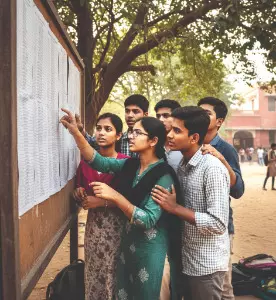The Uplift That Wasn’t
EWS quotas in higher education were a bond for the poorest, but have become a trap that the deserving fall through, while the rich ride it using forged papers

“Poverty is not natural. It is
only man-made and can be
overcome and eradicated by
the actions of fellow men.”
— Nelson Mandela
It arrived not as legislation, but as hope. For families living in rented single rooms, for parents juggling casual wages, for students studying under dim bulbs while their future felt permanently rationed by circumstance, the 103rd Constitutional Amendment was a thunderclap of possibility. When both Houses of Parliament cleared the 10-per cent reservation for Economically Weaker Sections (EWS) in January 2019, the applause was not just political, it was personal too. India had said what millions worldwide felt in silence – that poverty too deserved reservation. For the first time in independent India, affirmative action expanded beyond identity to include income.
The quota was planned as a gamechanger, one that would open doors in universities and government recruitment to students defined not by caste disadvantage but by economic deprivation. With nearly 23 crore Indians below the poverty line, and crores more in unstable near-poverty, the policy promised an escalator into India’s most coveted upward mobility machine: government institutions. The rules were clear. EWS seats would be carved from fresh allocation, leaving existing reservations for SC, ST and OBC untouched. Eligibility would be capped at an annual household income of Rs 8 lakh, combined with limits on land ownership and residential assets. Merit, Parliament said, would not be sacrificed, only expanded to include ‘merit born in hardship’.
Sadly, legislations don’t transform lives; implementation does. Five years after the hope handed out in 2019, the ledger of outcomes demands an uncomfortable audit.
Zoo of Misrepresentation
In principle, the quota was an attempt to identify poverty. In practice, it asked poverty to prove itself on paper. In a country where lakhs earn in cash, lack land titles and live outside digital documentation grids, certification was never a neutral administrative step. It was always going to be a new battlefield. What few anticipated, though, was how quickly it would become a business model.
Barely two years into the scheme’s rollout, reports surfaced from Uttar Pradesh, Bihar, Rajasthan, Maharashtra, Delhi and Madhya Pradesh, exposing a new underground service economy — the buying and selling of EWS certificates. Depending on the state, broker and urgency, prices ranged between Rs 25,000 and Rs 1.5 lakh. ‘Packages’ were on offer, including income certificates, landholding deeds, notary verification and, in some cases, ‘local administrative assurance’. India had learnt how to certify poverty for a commission.
In 2023, a sting investigation across five northern Indian districts uncovered 2,600 prima facie forged income certificates issued in a single admission cycle. The number of prosecutions was… Zero. Former NITI Aayog CEO Amitabh Kant summarised the flaw with unnerving precision: “We built an entitlement without building a verification architecture.”
Today, at many universities, EWS seats are filled at rates exceeding 95 per cent, higher than General or OBC occupancy. Statistically, it signals a roaring success. Sociologically, it is a regulatory collapse.
Poor Versus Paperwork
The most tragic twist in the EWS story is not that the undeserving have entered, it is that the deserving are being kept waiting. The salaried lower-middle class can verify earnings through bank statements, Form 16s, tax filings and digital footprints. But the truly poor; such as daily wage-earners, informal workers, domestic help, small tenant farmers and gig workers; often earn invisibly. Their money is real, but unrecorded. Their deprivation is evident, but undocumented.
A 2024 study by the Centre for Equity Studies showed 37 per cent of truly low-income applicants failed to produce documents acceptable for EWS certification. By contrast, only 11 per cent from stable income groups faced rejection on paperwork grounds. Simply put, the poorer the applicant, the less likely they are to clear the ‘poverty test’. A Supreme Court advocate called this a paradox of evidence: “The poor have hardship, but the privileged have paperwork.” EWS was meant to offset inequality. Instead, it has mirrored the oldest rule of inequality, that advantage adapts faster than policy.
How Others Verify Poverty
India is not the only country to extend benefits using economic thresholds. But it is among the few to do so without first building an impermeable verification system. In the US, need-based education assistance is validated through IRS-linked income records, with fraud carrying heavy federal penalties. Brazil’s ProUni scholarship programme cross-verifies household earnings with national tax and social security databases. China’s poverty alleviation schemes deploy ground-level audits backed by digitised household, land and employment registries.
Welfare systems globally are policed by digital verification and enforced by legal consequences. In India, verification is analog, decentralised and easily gamed. Deterrence is slow, weak or absent. Most countries build guardrails before disbursing benefits. India built benefits and handed them out, hoping that the requisite guardrails would follow.
Over the past three years, education watchdogs, student unions and faculty bodies have highlighted a troubling mutation, of EWS certificates being channelled for pre-identified candidates in high-stakes courses like medicine, engineering and law. In these cases, reservation is no longer a safety net; it is a procurement strategy. This is not administrative failure. It is philosophical corrosion. A policy designed to neutralise privilege is being weaponised to cement it.
Sociologist André Béteille once warned: “In India, inequality does not disappear; it just reinvents itself through new rules of legitimacy.” The EWS quota, intended to be a disruption, has been conscripted into inequality’s long project of reinvention.
Reform, Not Repeal
The answer lies not in abolition, but in reconstruction. Verification must shift from affidavits to system-authenticated data. PAN-Aadhaar income mapping, digitised land registries, GST-linked income trails for informal businesses and automated cross-validation can build a robust verification spine. After all, India has managed to architect instantaneous authentication for 13 billion UPI transactions a month… It should surely be able to verify 20 lakh EWS applications a year.
And fraud must carry consequence and punishment; admission cancellation is not deterrence enough. Multi-year education bans, financial penalties and criminal prosecution for forgeries must become standard. Processes must bend toward the poor, not away from them. Community certification models, presumptive eligibility for informal workers and institution-led documentation cells can help genuine applicants navigate bureaucratic proofs they are just not equipped to put together. Finally, universities must publish regular EWS audit reports, including acceptance rates, rejection causes, verification discrepancies and fraud detection.
EWS was conceived as an instrument of inclusion; it must not degrade into a tool for capture. Its very purpose was to reduce distance between talent and opportunity, not create earnings avenues for brokers. The poor do not ask for shortcuts, only fairness. The time to course-correct is now. If India fails, it won’t be the policy that is written off… What will die is the faith in what policy can achieve.
Soliloquy: In 2023, an RTI sweep across eight states revealed that fewer than 6 per cent of institutions verified EWS certificates post-admission. As many as 14 per cent of ‘checked’ cases showed serious discrepancies, but action followed in under 1 per cent. That same year, a student in Hyderabad was admitted via EWS but later found to be from a family owning three properties and a business filing GST returns of over Rs 40 lakh annually. His seat stood for two semesters before a review even began.
He can be reached on [email protected]. Views expressed are personal. The writer is a veteran journalist and communications specialist



